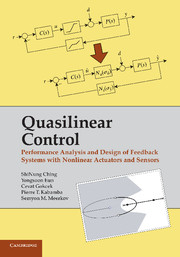 Quasilinear Control
Quasilinear Control Published online by Cambridge University Press: 01 June 2011
Motivation: The LQR and LQG techniques are widely used for designing disturbance rejection controllers for linear systems. In this chapter, quasilinear versions of these techniques are developed and extended to simultaneous design of controllers and instrumentation, that is, actuators and sensors.
Overview: We begin with developing the SLQR/SLQG technique, where the “S” stands for “saturated” (Section 6.1). Then, we extend LQR/LQG to the so-called ILQR/ILQG (where the “I” stands for “instrumented”), which is intended for simultaneous design of controllers, sensors, and actuators (Section 6.2). For each of these methods, we show that the solution is given by the usual Lyapunov and Ricatti equations coupled with additional trancendental equations, which account for the Lagrange multipliers of the associated optimization problems and the quasilinear gains. Bisection algorithms for solving these coupled equations are provided.
Saturated LQR/LQG
Scenario
The LQR/LQG design methodology is one of the main state space techniques for designing linear controllers for linear plants, assuming that the actuators and sensors are also linear. Clearly, this methodology is not applicable to nonlinear systems. Is an extension to LPNI systems possible? A positive answer to this question is provided in this section for systems with saturating actuators. The resulting technique is referred to as SLQR/SLQG, where the “S” stands for “saturated.” Extensions to other nonlinearities and to nonlinearities in actuators and sensors simultaneously are also possible using the approach presented here.
To save this book to your Kindle, first ensure [email protected] is added to your Approved Personal Document E-mail List under your Personal Document Settings on the Manage Your Content and Devices page of your Amazon account. Then enter the ‘name’ part of your Kindle email address below. Find out more about saving to your Kindle.
Note you can select to save to either the @free.kindle.com or @kindle.com variations. ‘@free.kindle.com’ emails are free but can only be saved to your device when it is connected to wi-fi. ‘@kindle.com’ emails can be delivered even when you are not connected to wi-fi, but note that service fees apply.
Find out more about the Kindle Personal Document Service.
To save content items to your account, please confirm that you agree to abide by our usage policies. If this is the first time you use this feature, you will be asked to authorise Cambridge Core to connect with your account. Find out more about saving content to Dropbox.
To save content items to your account, please confirm that you agree to abide by our usage policies. If this is the first time you use this feature, you will be asked to authorise Cambridge Core to connect with your account. Find out more about saving content to Google Drive.